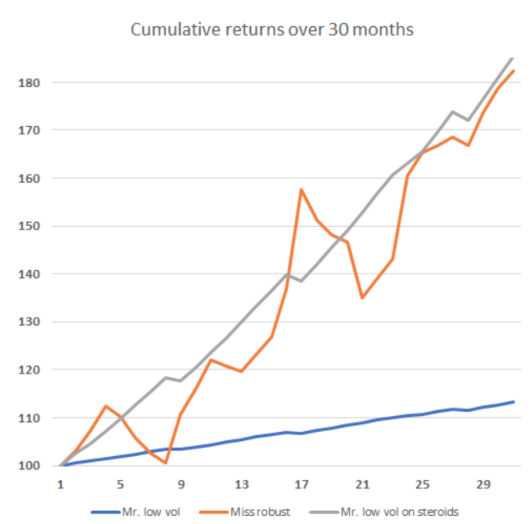In managing money, a keyword often comes up but is easily misunderstood: robustness. What does it mean for an investment strategy to be “robust”? What does a robust strategy look like? Is it something that most investors find palatable? Look at the following returns for two different managers, Mr. Low Vol and Miss Robust.

On the other hand, Miss Robust (orange line) generates lumpy returns, compounding her capital to 82.3% (27.2% annualized), but with a couple of gut-wrenching drawdowns, including one that exceeds -15% between months 18 and 21.
Let’s get philosophical for a minute. Neither of these managers is “ideal” from the perspective of what an investor truly wants. Most institutional investors – whether high net worth families or endowments or pensions – have annual spending hurdles, which can often be approximated with a 5% rule of thumb. To manage their portfolios for the long haul, they need returns to be greater than their [spend rate + inflation + a real return component]. Mr. Low Vol doesn’t deliver enough return to meet investor requirements from a long-term increase in real returns perspective. Although Miss Robust does, she offers a mini heart attack now and then, leaving the investor pleading for a third option.
But wait! Couldn’t that third option be as simple as levering Mr. Low Vol’s returns 5x to generate the “Mr. Low Vol on steroids” gray line in the chart? Be careful, as this version of Mr. Low Vol is booby-trapped. Much like the opening of Raiders of the Lost Ark, investors will find themselves in the position of Indiana Jones the moment they grab the golden idol. Those returns will certainly not last, and much as Jones faced spikes, a massive stone boulder, and a tribe of Indians shooting arrows at him before his narrow escape, our investor will face option writing strategies with 80% drawdowns ahead of them and leveraged bond. FX carry strategies with similar massive “event risk” drawdowns in the future, among others. Lesson: the past thirty years have taught us that it’s impossible to take a low-vol strategy and lever it up 5, 10, or 20 times. To pervert the slogan of America’s most famous sneaker company: “Just don’t do it.”
Like “Mr. Low Vol on steroids,” the past ten years of a non-stop, low-interest rate-driven bull market have obscured hidden risks in three mainstream strategies: long-only, tech-heavy equity portfolios, private equity, and private real estate. The first (tech-heavy stock portfolio) is a long-duration asset that no longer commands a P/E multiple premium when the interest rate environment changes. And the latter two are both leveraged plays on assets that have boomed during that same low-rate environment.
This brings us back to Miss Robust. Sure, she’s not the prettiest girl in the nightclub. You’ve gone back to talk to her because you just realized your first choice shot you down. But she’s the one who will make your best partner for the long haul, regardless of whether the markets are driven by deflation, high inflation, or changing bid-offer sub-structures due to the constantly shape-shifting algorithms of the high-frequency shops that provide the majority of liquidity these days. Nothing matters when you focus on the big picture and take your inevitable lumps and losses as Miss Robust does.
Are we talking about our book as we write this letter? It may seem that way, but does that matter if what we’re saying is pretty much common sense? We’ve had enough conversations with prospective investors to offer our perspective on what sort of return stream embodies longevity. In short, robust returns are not smooth, cannot be smoothed out, must have drawdowns, and – most importantly – are meant to be impervious to whatever changes occur to markets (both to participants and underlying structures) for decades. A robust return structure is intended for building an investment career rather than making a quick buck over several years.
AG Capital is a fundamental, long/short macro investment firm trading across currencies, commodities, interest rates, and equity futures.
The firm follows a fundamentally oriented, discretionary long/short macro investing. We look for opportunities where an imbalance between supply, demand, and inventories (where applicable) may lead to a large price move. Position hold times vary from 1 month to year; there is no day trading or algorithmic trading. Fundamental analysis is used to determine directional exposure, both long and short. Technical analysis determines trade timing: enter and exit positions where extreme asymmetry exists from a risk/reward standpoint.
